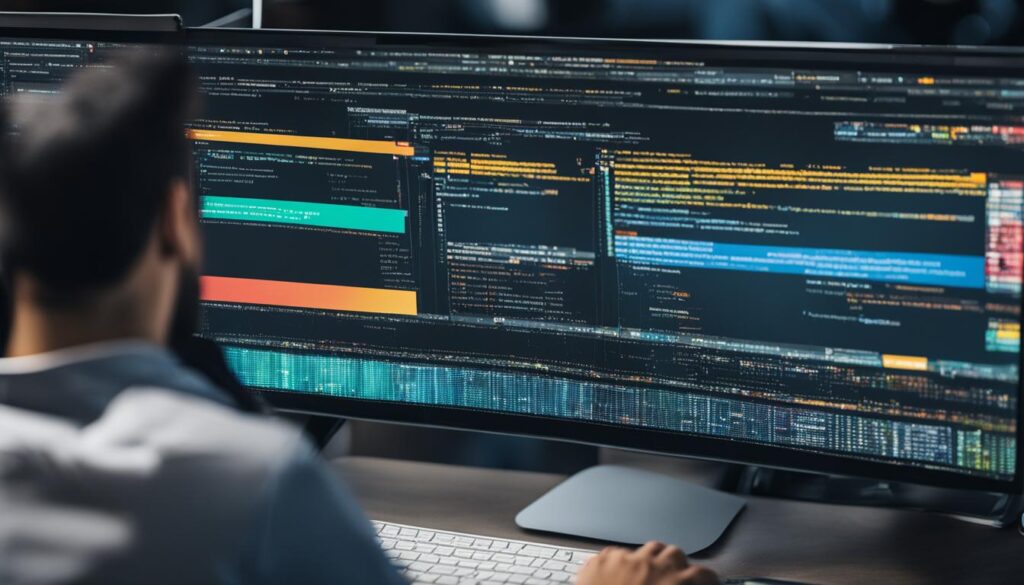Technology has become an integral part of our lives, and it can also be used as a valuable tool for studying information technology (IT). By incorporating technology into your study routine, you can enhance your learning experience and improve your understanding of IT concepts. In this guide, we will explore various techniques, strategies, and best practices for studying IT effectively. Whether you’re a beginner or an advanced student, these tips will help you ace your IT studies.
Contents
- 1 Understanding Different Learning Styles in IT Education
- 2 Utilizing Technology for Effective IT Studying
- 3 Creating Effective Study Notes and Materials for IT
- 4 Collaborative Learning and Study Groups in IT Education
- 5 Time Management and Effective Study Techniques for IT
- 6 Conclusion
- 7 FAQ
- 7.1 What are some effective study techniques for information technology (IT) education?
- 7.2 How can I understand my learning style in IT education?
- 7.3 What technology tools and resources can I use to study IT effectively?
- 7.4 How can I create effective study notes and materials for IT?
- 7.5 What are the benefits of collaborative learning and study groups in IT education?
- 7.6 How can I manage my time effectively when studying IT?
- 7.7 How can I apply my IT knowledge in practical scenarios?
- 7.8 What are some final thoughts on studying IT effectively?
- 8 Source Links
Key Takeaways:
- Discover effective IT study techniques
- Utilize technology to enhance your IT studies
- Understand different learning styles in IT education
- Create organized study notes and materials for IT
- Engage in collaborative learning and study groups
Understanding Different Learning Styles in IT Education
When it comes to studying IT, it’s important to understand your learning style. People have different ways of processing and retaining information, and tailoring your study techniques to match your learning style can greatly enhance your learning experience.
Some common learning styles in IT education include:
- Visual learners: Visual learners benefit from visual aids, such as diagrams, charts, and videos. They learn best when information is presented in a visual format. Utilizing visual resources can help visual learners grasp IT concepts more easily.
- Auditory learners: Auditory learners learn best through listening and speaking. They can enhance their understanding of IT concepts by using audio materials, such as recorded lectures or podcasts, and by engaging in discussions with peers or instructors. Active participation in verbalizing and re-explaining concepts can also strengthen their understanding.
- Kinesthetic learners: Kinesthetic learners prefer hands-on activities and practical experiences. For these learners, incorporating interactive exercises, real-world applications, and experiential learning can greatly improve their retention and comprehension of IT topics.
To cater to visual learners, providing visual aids like diagrams, charts, and videos can be highly effective. For auditory learners, offering audio materials, facilitating discussions, and encouraging verbal repetition can enhance their learning experience. Kinesthetic learners benefit from hands-on activities, simulations, and real-world applications that allow them to actively engage with the material.
Understanding your own learning style and employing techniques that align with it will help you study IT more effectively.
Comparison of Learning Styles in IT Education
| Learning Style | Characteristics | Effective IT Study Techniques |
|---|---|---|
| Visual Learners | Preference for visual aids and imagery | Utilize diagrams, charts, videos, and visual resources |
| Auditory Learners | Best understanding through listening and speaking | Use audio materials, engage in discussions, explain concepts aloud |
| Kinesthetic Learners | Hands-on learning and practical experiences | Incorporate interactive exercises, real-world applications, and experiential learning |
Understanding and accommodating different learning styles can significantly improve your IT studying experience and help you achieve better results.
Utilizing Technology for Effective IT Studying
Technology is revolutionizing how we study information technology (IT). By leveraging technology tools and resources, you can enhance your IT learning experience and improve your understanding of complex concepts. Whether you are a beginner or an advanced student, incorporating technology into your study routine can make a significant difference.
One of the key advantages of technology in IT studying is the accessibility to online resources. There is a wealth of tutorials, videos, and study materials available on the internet that cover a wide range of IT topics. You can access these resources anytime and anywhere, allowing for flexible and self-paced learning. Online platforms provide interactive learning experiences with quizzes, exercises, and assessments to test your knowledge and reinforce your understanding of IT concepts.
Additionally, educational apps have emerged as powerful tools for IT studying. These apps offer engaging content, interactive exercises, and gamified learning experiences. You can download educational apps dedicated to IT studies, such as coding practice, networking simulations, and cybersecurity challenges, to deepen your knowledge and skills in specific IT domains.
Virtual labs are another valuable resource for IT practice. These labs provide a simulated IT environment where you can apply your knowledge and practice hands-on skills. Whether it’s configuring networks, conducting cybersecurity tests, or troubleshooting software issues, virtual labs offer a safe and controlled space to refine your practical abilities.
It’s worth mentioning the rise of interactive learning platforms that foster collaborative learning and engagement. These platforms enable you to join IT study groups, discuss concepts with classmates, and participate in group projects. Group collaboration allows for peer-to-peer learning, sharing of ideas, and problem-solving, creating a dynamic and enriching IT learning environment.
By utilizing technology for IT studying, you can harness the power of online resources, educational apps, and virtual labs to augment your traditional study materials. This integration of technology enhances interactivity, engagement, and accessibility in your IT learning journey.
Creating Effective Study Notes and Materials for IT
Taking effective study notes and organizing study materials are essential for successful IT studying. To create study notes that work for you, consider utilizing tools like Microsoft Word or note-taking apps to type out your notes. This allows for easy editing, searching, and organizing your study materials. Break down complex IT concepts into concise and understandable summaries. Use headings, bullet points, and diagrams to visually organize your notes. These techniques help you review and revise IT concepts more efficiently. Moreover, consider creating comprehensive study guides that condense important information and highlight key concepts. These study materials serve as valuable resources for quick reference and revision.
Note-taking Techniques for IT
When it comes to taking notes for IT, there are various techniques you can employ to ensure effective learning and understanding of the subject matter. Some popular note-taking techniques for IT include:
- Outline method: Structuring your notes using headings, subheadings, and bullet points.
- Cornell method: Dividing your notes into three main sections – cues, notes, and summary.
- Mind mapping: Creating visual diagrams to connect different IT concepts and their relationships.
- Charting method: Utilizing tables and charts to organize and categorize information.
Experiment with these techniques to find the one that suits your learning style and enables you to effectively summarize and retain IT concepts.
Organizing IT Study Materials
In addition to taking notes, organizing your study materials is crucial for efficient IT studying. Consider the following strategies to keep your materials organized:
- Create a dedicated folder or binder for IT study materials.
- Label and categorize your study materials based on topics or subjects.
- Utilize digital tools or note-taking apps that offer organization features.
- Use color-coding techniques to visually differentiate different types of study materials.
By organizing your study materials, you can easily find and review specific topics or concepts when needed, saving you valuable time and effort.
Summarizing IT Concepts
“In learning you will teach, and in teaching you will learn.” – Phil Collins
Summarizing IT concepts is an effective way to reinforce your understanding and retention of the material. When summarizing, focus on capturing the essence of the concept in a concise and understandable format.
To summarize IT concepts effectively, follow these steps:
- Read the material thoroughly to ensure you grasp the main ideas.
- Identify the key points and important details that support the main ideas.
- Condense the information into short, coherent sentences or bullet points.
- Avoid copying word-for-word; instead, rephrase the information using your own words.
By summarizing IT concepts, you create condensed study resources that are easier to review and can serve as a quick reference during exams or when revisiting a topic.
Remember, the goal of creating effective study notes and materials is to facilitate your learning process and aid in comprehension and retention. Experiment with different methods, be consistent in organizing your materials, and develop a summarization technique that works best for you.

Collaborative Learning and Study Groups in IT Education
Collaborative learning and study groups provide a valuable opportunity for IT students to enhance their understanding of complex concepts. By actively participating in a study group or joining an IT study club, you can engage in peer-to-peer learning and gain different perspectives that deepen your knowledge. Collaborating with classmates creates an environment conducive to discussion, problem-solving, and clarification, allowing you to tackle challenging IT topics with support.
One of the key advantages of study groups is the ability to share knowledge and exchange study materials. This exchange of resources helps everyone in the group strengthen their understanding of IT concepts and reinforce their learning. Study groups also enable you to capitalize on the expertise of others, as you can learn from your peers’ unique insights and experiences.
Furthermore, group study sessions foster motivation, accountability, and time management skills. When you study with others, you are more likely to stay focused and committed to your study goals. The collective effort and shared responsibility within a study group create a motivating environment that drives you towards success.
Technology tools like WhatsApp and Google Drive can greatly facilitate communication and collaboration within study groups. These platforms allow for easy document sharing, instant messaging, and real-time collaboration, making it convenient to discuss ideas, clarify doubts, and plan group study sessions.
| Benefits of Collaborative Learning and Study Groups | Example |
|---|---|
| Peer-to-peer learning | Engaging in discussions and knowledge exchange with classmates |
| Enhanced understanding | Gaining different perspectives and insights from peers |
| Shared resources | Exchanging study materials and learning from others’ resources |
| Motivation and accountability | Staying motivated and committed to study goals with support from the group |
| Improved time management | Utilizing group study sessions to effectively manage studying time |
Collaborative learning and study groups in IT education provide a platform for collective growth, collaboration, and a deeper understanding of IT concepts. Take advantage of these opportunities to enhance your learning journey and maximize your success in the field of information technology.

Time Management and Effective Study Techniques for IT
When it comes to studying IT effectively, time management is crucial. By implementing effective time management strategies, you can optimize your study sessions and make the most out of your IT study time. Here are some techniques to help you manage your time and enhance your IT studying:
- Create a study schedule: Allocate dedicated time for your IT studies and create a schedule that outlines the topics you need to cover. This will ensure that you have sufficient time to review all the necessary material.
- Prioritize your study tasks: Identify the importance and urgency of each study task. Prioritize tasks accordingly, focusing on those that require immediate attention. This will help you allocate your time efficiently and avoid procrastination.
- Break down your study sessions: Instead of long, uninterrupted study sessions, break your study time into focused intervals. One popular technique is the Pomodoro Technique, where you work for 25 minutes and then take a short break. This method helps maintain focus and productivity.
- Eliminate distractions: During your study sessions, eliminate distractions such as social media and unrelated websites. Find a quiet study space, silence notifications, and focus solely on your IT studies.
- Set specific goals: Before each study session, set specific goals to accomplish. Having clear objectives will keep you motivated and on track. Celebrate your accomplishments by rewarding yourself upon completion of each goal.
By implementing these time management techniques, you can optimize your IT study time, increase your productivity, and effectively manage your workload. Remember, effective time management is essential for success in IT studies.
Focused Studying Techniques
In addition to time management, focused studying techniques can help you absorb information and improve your understanding of IT concepts. Here are some strategies to enhance your focused studying:
- Active reading: Instead of passive reading, actively engage with the material by highlighting key points, taking notes, and summarizing concepts in your own words. This will improve your retention and comprehension of the material.
- Practice problem-solving: IT involves problem-solving skills. Practice by solving IT-related problems or working on coding exercises. This hands-on approach will deepen your understanding and build your problem-solving abilities.
- Teach others: Explaining IT concepts to others can solidify your understanding of the subject matter. Find study partners or teach a concept to a friend or family member to reinforce your knowledge.
- Utilize visual aids: Diagrams, charts, and infographics can visually represent complex IT concepts and make them easier to understand. Create your own visual aids or seek out online resources that provide visual explanations.
By incorporating these focused studying techniques into your study routine, you can enhance your learning and improve your performance in IT studies.

| Practical Application | Benefits |
|---|---|
| Hands-on IT exercises | Enhances understanding of IT concepts |
| Real-world projects | Develops practical IT skills |
| IT case studies | Applies knowledge to real-world scenarios |
| IT internship opportunities | Gains practical experience in a professional environment |
Conclusion
Congratulations on completing the IT study guide! By incorporating technology, understanding your learning style, and utilizing effective study techniques, you can study information technology more efficiently and effectively. Throughout this guide, we have explored various strategies and best practices that will help you ace your IT studies.
Remember, IT studying is a continuous process that requires dedication, practice, and a growth mindset. Embrace your curiosity and keep exploring the dynamic field of information technology. As you embark on your IT study journey, never stop learning and stay up to date with the latest advancements and trends in the industry.
As you apply what you’ve learned, don’t be afraid to seek support from study groups, collaborate with your peers, and take on real-world projects. Practical application of your IT knowledge and skills will not only reinforce your understanding but also prepare you for the challenges and opportunities that await you in the IT industry.
Good luck on your IT study journey! With the right mindset, effective study techniques, and a commitment to continuous improvement, you can achieve great success in the fascinating world of information technology.
FAQ
What are some effective study techniques for information technology (IT) education?
Some effective study techniques for IT education include understanding your learning style, utilizing technology tools and resources, creating comprehensive study notes and materials, participating in collaborative learning and study groups, managing your time effectively, and engaging in practical application and real-world projects.
How can I understand my learning style in IT education?
Understanding your learning style in IT education involves recognizing whether you are a visual learner, auditory learner, or kinesthetic learner. Once you know your learning style, you can tailor your study techniques to match it and enhance your learning experience.
What technology tools and resources can I use to study IT effectively?
There are various technology tools and resources available for studying IT, including online platforms, educational apps, and virtual labs. These resources provide interactive learning opportunities, access to tutorials and study materials, and the ability to practice hands-on skills in a simulated IT environment.
How can I create effective study notes and materials for IT?
To create effective study notes and materials for IT, consider using tools like Microsoft Word or note-taking apps to type out your notes. Break down complex concepts into concise summaries, use headings and diagrams to visually organize your notes, and create comprehensive study guides that highlight key concepts.
What are the benefits of collaborative learning and study groups in IT education?
Collaborative learning and study groups in IT education provide opportunities for peer-to-peer learning, discussion, clarification, and problem-solving. By collaborating with classmates, you can gain different perspectives, share knowledge, exchange study materials, and help each other understand challenging IT topics.
How can I manage my time effectively when studying IT?
To manage your time effectively when studying IT, create a study schedule that allocates dedicated time for studying IT topics. Prioritize your study tasks, break down your study sessions, eliminate distractions, set specific goals, and use techniques like the Pomodoro Technique to maintain focus and productivity.
How can I apply my IT knowledge in practical scenarios?
To apply your IT knowledge in practical scenarios, look for opportunities to engage in hands-on exercises, simulations, case studies, and even IT internship opportunities. Applying your knowledge to solve practical problems and engaging in real-world projects helps reinforce your understanding of IT concepts and prepares you for challenges in the IT industry.
What are some final thoughts on studying IT effectively?
Studying IT effectively requires dedication, practice, and a growth mindset. Incorporate technology into your study routine, understand your learning style, utilize effective study techniques, collaborate with others, manage your time wisely, and engage in practical application. Never stop learning and stay curious in the dynamic field of information technology.




